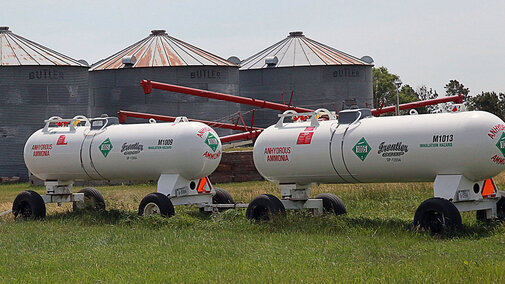Anhydrous ammonia has been used since the 1940s to efficiently deliver nitrogen to growing plants. While it can dramatically increase crop growth, anhydrous ammonia also can quickly lead to death if it’s mishandled.
How Anhydrous Burns
Anhydrous ammonia seeks water and is naturally attracted to our eyes, nose, mouth, sweat glands, and genitalia. Because anhydrous is normally at a temperature of -44°F, it freezes tissue on contact and can inflict an incredibly painful alkali burn.
— Dan Neenan, director of the National Education Center for Agricultural Safety (NECAS)
In an effort to improve safe handling of anhydrous ammonia, the Central States Center for Agricultural Safety and Health at the University of Nebraska Medical Center is working with Dan Neenan, paramedic and director of the National Education Center for Agricultural Safety (NECAS), to bring safety training to farmers, cooperative employees, and the public.
A hands-on safety training, using an anhydrous tank simulator, will be held at the Mid-America Center in Council Bluffs Thursday Nov. 29, from 1-2:30 p.m. The training will be targeted to farmers, elevator and co-op staff, and the public. The cost is $10 and includes a lunch at noon. Information and registration is available online or by calling 800-551-9029.
Neenan discussed why understanding the hazards associated with anhydrous ammonia is important.
“This chemical is desperately seeking water,” he said. “Our bodies are 70% water, so anhydrous ammonia is naturally attracted to our eyes, nose, mouth, sweat glands and genitalia. Because anhydrous is normally at a temperature of -44°F, it freezes tissue on contact. It pulls moisture out of tissue and inflicts an incredibly painful alkali burn.”
Unlike many burns, an anhydrous ammonia burn is treated by flushing with water to wash the chemical off the skin. If creams or ointments are used without flushing, the chemical is trapped in the tissue and continues to burn.
“Our lungs are wet so if you inhale anhydrous ammonia, your lung tissue is burned,” Neenan said. “Any time tissue is burned, it swells. Because our airway has a limited space to take air in, inhaling anhydrous ammonia can quickly result in our airway being closed off.”
Donning appropriate personal protective equipment (PPE) is key to safely handling anhydrous ammonia. Among necessary gear is a full-face respirator. The respirator needs to be a high-efficiency P100 particulate filter with a minimum 99.97% filtration efficiency for solid and liquid aerosols. A respirator’s face seal design also provides a high degree of protection for eyes and airways.
Gloves must be impervious, chemical-resistant, and in compliance with approved standards for handling chemical products. Check gloves regularly to ensure they retain intended protective properties.
“I also recommend wearing a chemical resistant rainsuit or rainwear rated to protect against anhydrous ammonia,” Neenan said. “Cotton lined gloves must have a fold-over cuff so any anhydrous ammonia that might get on the glove doesn’t run down your sleeve and burn your arm or get into your sweat glands.”
Footwear should include chemical resistant “boots” that slip over standard boots and protect feet from accidental exposure to hazardous chemicals.
Be Ready for the Unexpected
A main precaution for anhydrous ammonia use includes approaching tanks with caution in case someone has tampered with a shutoff or compromised the tank in some way.
“When people steal anhydrous ammonia to make methamphetamine, they’re not concerned about getting it properly shut off,” Neenan said. “That means the next person approaching the tank is at risk for injury. Never approach a tank without appropriate PPE and always inspect it carefully before hooking it to any equipment. Ensure no one has tampered with it.”
It’s also key to note wind direction before approaching a tank. If a leak has occurred, it will be swept along on the wind. Anyone in its path is at high risk for injury.
“Our instinct when approaching something is to go back the way we came if there’s danger,” Neenan said. “With anhydrous ammonia, if there’s a leak, you want to stay upwind. Always check the wind direction before going near the tank.”
The Anhydrous Safety Training Workshop is part of the Midwest Rural Agricultural Safety and Health Conference Nov. 27-29 in Council Bluffs.

